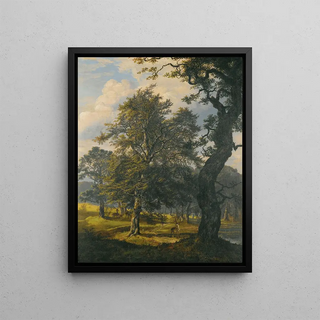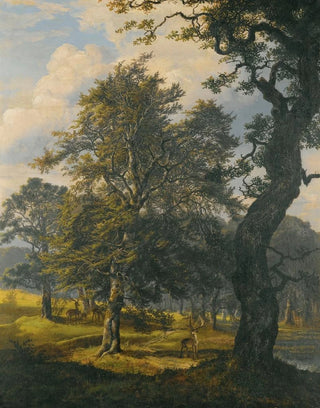Art print | The zoo near Copenhagen - Johan Christian Dahl


View from behind

Frame (optional)
In the 19th-century artistic landscape, few works manage to capture the essence of a place with as much poetry and delicacy as "Le zoo près de Copenhague" by Johan Christian Dahl. This canvas, which evokes the serenity of a Danish landscape, transports the viewer into a universe where nature and art meet harmoniously. Through this art print, the piece offers a visual journey into a lively scene, where wildlife and the natural environment intertwine to create an atmosphere that is both vibrant and soothing. The soft light bathing the composition invites meditative contemplation, while the meticulous details of the animals and their habitat reveal a particular attention to the reality of the natural world.
Style and uniqueness of the work
Johan Christian Dahl's style is distinguished by his ability to blend realism and romanticism. In "Le zoo près de Copenhague," the artist manages to create an ambiance that is both true to life and imbued with lyricism. The colors, carefully chosen, evoke the softness of a Danish morning, while the shapes of the animals and trees are rendered with a precision that reflects the artist's attentive observation. Each element of the composition seems alive, almost animated by an inner force. The contrasts between shadow and light, as well as the way natural elements harmonize, demonstrate impressive technical mastery. This work does not merely depict a zoo; it invites the viewer to feel the interconnectedness between man, animal, and nature, offering a reflection on our place in the world.
The artist and his influence
Johan Christian Dahl, often considered the father of Danish landscape painting, played a crucial role in the development of Nordic art in the 19th century. Trained in Germany, he was influenced by the masters of romantic landscape, but he adapted these inspirations to his own cultural context. His ability to capture the light and atmosphere of Scandinavian landscapes left a mark on his contemporaries and paved the way for many artists. Dahl was also a pioneer in the representation of wildlife, incorporating animal elements into his landscapes.

Matte finish

View from behind

Frame (optional)
In the 19th-century artistic landscape, few works manage to capture the essence of a place with as much poetry and delicacy as "Le zoo près de Copenhague" by Johan Christian Dahl. This canvas, which evokes the serenity of a Danish landscape, transports the viewer into a universe where nature and art meet harmoniously. Through this art print, the piece offers a visual journey into a lively scene, where wildlife and the natural environment intertwine to create an atmosphere that is both vibrant and soothing. The soft light bathing the composition invites meditative contemplation, while the meticulous details of the animals and their habitat reveal a particular attention to the reality of the natural world.
Style and uniqueness of the work
Johan Christian Dahl's style is distinguished by his ability to blend realism and romanticism. In "Le zoo près de Copenhague," the artist manages to create an ambiance that is both true to life and imbued with lyricism. The colors, carefully chosen, evoke the softness of a Danish morning, while the shapes of the animals and trees are rendered with a precision that reflects the artist's attentive observation. Each element of the composition seems alive, almost animated by an inner force. The contrasts between shadow and light, as well as the way natural elements harmonize, demonstrate impressive technical mastery. This work does not merely depict a zoo; it invites the viewer to feel the interconnectedness between man, animal, and nature, offering a reflection on our place in the world.
The artist and his influence
Johan Christian Dahl, often considered the father of Danish landscape painting, played a crucial role in the development of Nordic art in the 19th century. Trained in Germany, he was influenced by the masters of romantic landscape, but he adapted these inspirations to his own cultural context. His ability to capture the light and atmosphere of Scandinavian landscapes left a mark on his contemporaries and paved the way for many artists. Dahl was also a pioneer in the representation of wildlife, incorporating animal elements into his landscapes.






